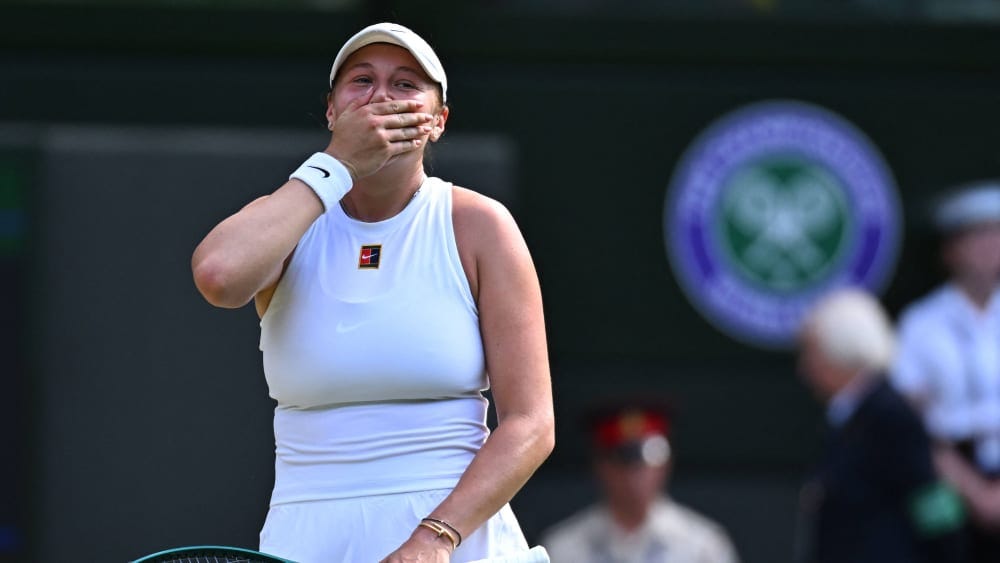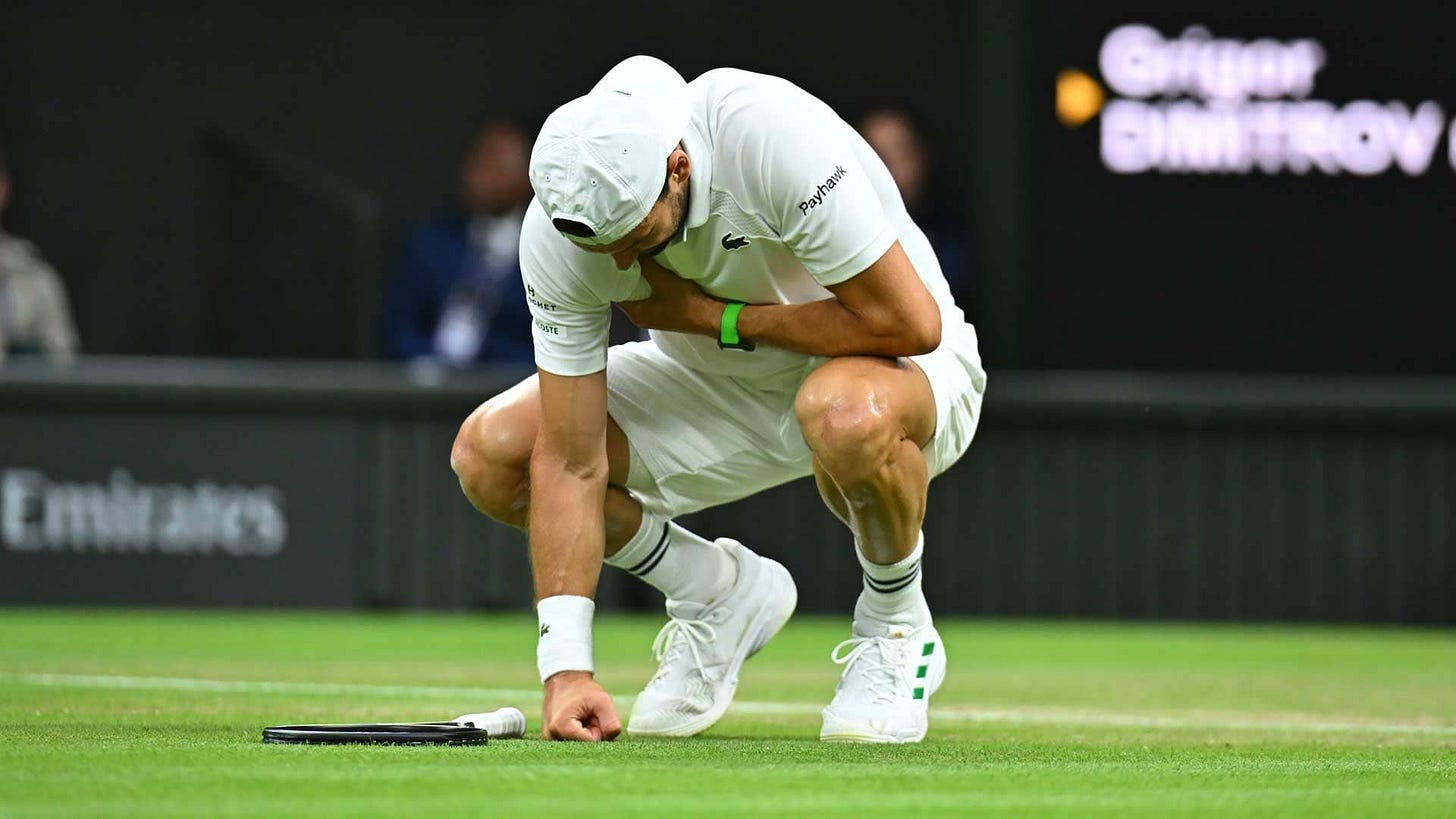In a way, Amanda Anisimova and Grigor Dimitrov were the defining stories of Wimbledon. It may have been Jannik Sinner and Iga Swiatek who triumphed and who everyone talked about but if you look closely, it’s Amanda and Grigor’s narrative that is the more human one. Let me explain what I mean.
We love winners because often times in their winning, we see ourselves. Even if we haven’t won a single thing, when we see one of them raise a trophy, they hold not only the trophy but all the possibilities a lifetime bears. We love sports for the drama and tragedy, yes, but we mainly love it because someone ends up winning. In sports, there is always a happy end. In life, winning is not guaranteed.
I don’t know what came first, sports or art, the chicken or the egg, but sometimes it feels to me that art is there to capture humans fail and sports is there to capture them overcome. We see Jannik and we see Iga and we see all the obstacles they have put behind them. They were the sports side of the Wimbledon coin, the side that found its climax in their beautiful champions’ dance. But to make the coin whole, to make the Wimbledon experience a real one, a human one, we need the other half of it. The other half is tragedy, the other half is art.
When Amanda chose to step away from tennis to heal exhaustion and mental health struggles, the tennis world applauded her for her courage. To be honest, I was not one of them. Not because I don’t think that these kinds of breaks are not important but because I was worried she will never come back. And having seen her talent and having had the questionable pleasure of being on the other side of the net of it, I thought we might have lost yet another star to the rigours of the tennis world, a hungry beast that eats and eats. But Amanda was tougher than I thought, too tough for the beast to devour. She came back and within a year she won her first WTA 1000 title in Doha.
Then Wimbledon came around and it all could have been, it all should have been a fairytale, the cherry on top of a perfect comeback story, but the Iga train rolled all over it. People felt disappointed. They felt robbed of a potential fairytale. We sometimes forget that at the end of fairytales somebody’s eyes get picked by crows. At least in German ones.
When Grigor played the perfect two sets and a half tennis fans were joyous. So beautiful his technique, so effortless his talent! He was toying with Jannik, pairing nett attacks with sharply hit slices, powerful forehands with smartly placed drop shots. Until his muscle tore. There was no warning, no inkling except for the notion that this had happened before, that this was Grigor’s tragedy in a way. How many times had he been so close and how many times did his body fail him? Once is unlucky, twice is a coincidence, more than two times is a narrative.
We pitied Amanda and we pitied Grigor. But pitying someone means keeping them at a distance. Pity is not real empathy. We come to sports for escapism, we don’t want to be reminded of the fallible human nature, we don’t want to be reminded that we can be outplayed or that a lack of health can strike at every moment. We want to see smiling Jannik and beaming Iga.
The worst part is that both Amanda and Grigor are in the 0,1% of most talented people on the planet. If these things can happen to them, how are we supposed to be able to cope with what life throws at us? This is where art comes in to play. We turn to sports to escape, we turn to art to understand.
Art has always been able to extract meaning from things that seem meaningless. Why does Amanda have to lose 0 and 0? Why can’t it be 7:5 6:4? Why does Grigor’s muscle pop? Why can’t it remain in place for another 45 minutes? We may try to channel our inner Sinner, the Roman stoic who accepts his fate. Or we turn into nihilists: Nothing matters. We can try on the dress of American positivity, find upsides in everything, even a torn muscle at 34. There are many ways to deal with losses.
I fall somewhere in the middle of it with a strong lean towards American positivity. I am an optimist at heart after all. What I took away from the specific cases of Amanda and Grigor, though, is how hard, how almost impossible, it is to win a Grand Slam tournament. How many stones need to fall into place for an individual to stay healthy, remain mentally and emotionally intact, overcome tiredness and the typical mid-Slam slump that sets in after day 7, perform at the highest of levels possible considering it all and beat the best tennis players in the whole wide world that have gathered to get you. You cannot have nerves get to you, you cannot have the press get to you, you cannot have the other players get to you. 2 weeks, 7 matches, x amount of sets and games and points, 3 meals a day that may contain a virus or food poisoning, air conditioned locker rooms that may strike you with a cold, 14 nights of possible nightmares and hundreds of text messages that could upset you. You have to overcome and overcome and overcome and when it’s all said and done, you have to overcome some more. It never ends.
With the years, I have gotten better at appreciating moments rather than entire narratives (for a mind poisoned by novel reading not an easy thing to shake). I choose to remember Amanda’s forehand cross court winner on match point against Aryna Sabalenka. I choose to remember Grigor’s perfect serve-and-volley execution. And most of all, I choose to remember Grigor’s girlfriend’s Eiza Gonzalez’ perfect jawline (seriously, she stood next to me in line waiting for a smoothie and I nearly fainted).
History remembers the winners in sports. Art remembers the other ones. They are not losers, no, only in sports does losing exist in such cruel way. They are the ones who get bullied in art school for being a terrible craftsman only to go ahead and revolutionise paintings like Jackson Pollock did. They are the ones who choose simplicity to express emotions and get ridiculed for it like Ernest Hemingway. They are all the Jazz musicians in this world and they are The Beatles and The Rolling Stones. I think what I’m trying to say is: In art, there are many ways to succeed. Unfortunately in tennis, there’s only one. That’s why we here at Finite Jest celebrate them all, particularly Amanda Anisimova and Grigor Dimitrov.
Things that make me happy:
Definitely Eiza Gonzalez’ jawline. Also peppermint tea in the morning. I also really enjoyed the storyline in Netflix’ The Sandman season 2 where the devil Lucifer basically has a burnout and abandons hell. Lovely.
Things that make me unhappy:
In the category of things I will never understand falls the bizarre choice of putting carpets in places like airports, hotels or trains. Places where people clearly go because they travel and chances are they carry a suitcase that has tires on the bottom WHICH GET STUCK IN THE CARPETS OF YOUR GENIUS PLANS. Stop putting carpets in places where people travel. I beg of you.
I hope you have gotten rid of the post-Grand Slam blues by now. Peppermint tea with honey is a remedy i strongly believe in as is drinking too much coffee. And if you do both at the same time, you might as well just lock yourself in the bathroom. With an open heart and closed bathroom doors I remain…
Yours truly, Andrea







As always, Thoughtful and illuminating. One minor quibble. A couple of times you mentioned American positivity which was once true. At the moment we are wading into the waters of nihilism and a big wave is coming.
Great read, Andrea.
I enjoy that you've highlighted what most people forget (the beauty is in the journey not the the outcome).
I feel like their journeys are all equally human. Whether you leave with the title or not, the outcomes are all incredibly human.